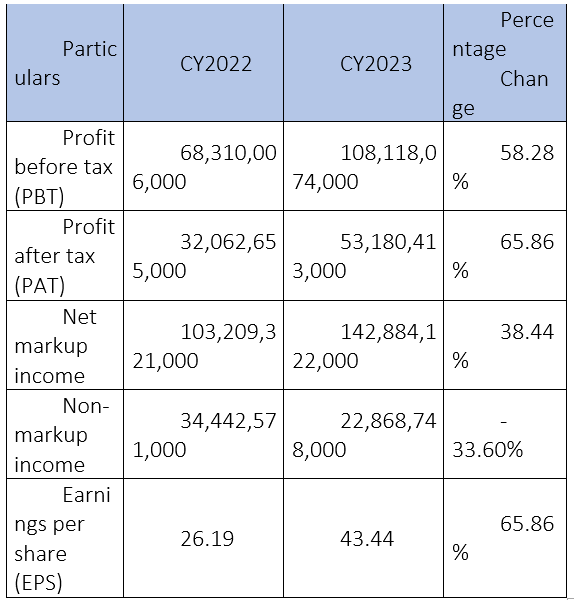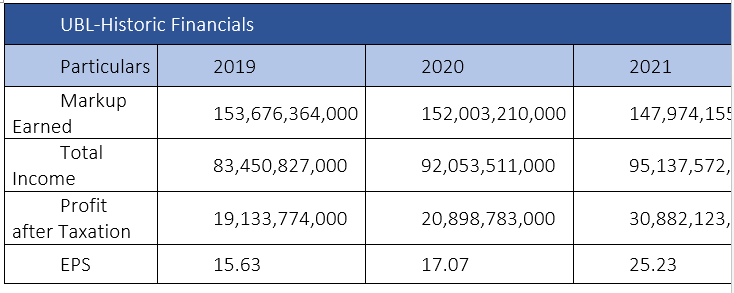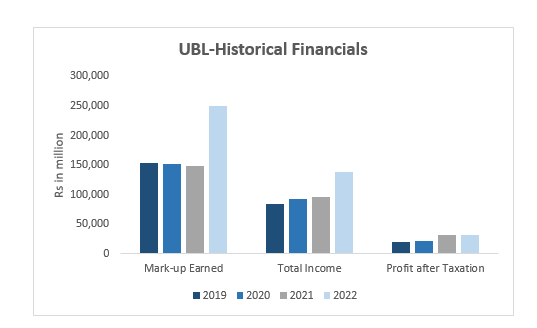INP-WealthPk
Ayesha Mudassar
United Bank Limited (UBL), one of the country's largest commercial banks, posted an unconsolidated profit-after-tax (PAT) of Rs53.1 billion for the year ended December 31, 2023, with notable growth of 65.8% over the previous year, reports WealthPK. According to the financial results submitted to the Pakistan Stock Exchange (PSX), the bank recorded a profit-before-tax (PBT) of Rs108.1 billion for CY23 versus a PBT of Rs68.3 billion in the calendar year 2022. The improved profitability was primarily fuelled by higher net interest income and provisioning reversals.
UBL announced an impressive earnings per share (EPS) of Rs43.44 for CY23. The net markup income posted immense growth, reaching Rs142.8 billion for CY23, compared to Rs103.2 billion in CY22. High interest rates along with timely repositioning within the asset base improved margins during the period under review. However, non-markup interest income for the year dwindled 33.6% to Rs22.8 billion year-on-year. Higher fees and foreign exchange income were offset by a loss on securities and an enormous decline in other income.
![]()


The bank's continuous focus on expediting the digital transformation journey, combined with delivering 'unparalleled' services to the customers facilitated a robust fee income growth of 10.4%, reaching Rs17.5 billion during calendar year 2023 from Rs15.8 billion over the year earlier. Foreign exchange income increased by 49% to reach Rs12.4 billion for the year ended December 31, 2023, as compared to Rs8.4 billion for the year ended December 31, 2022. Meanwhile, the bank sustained massive net losses on securities to Rs9.9 billion in CY23, compared to a gain of Rs466 million in the earlier calendar year. Furthermore, operating expenses increased 23% to Rs64.3 billion in line with the bank's strategy to invest in digital technology platforms alongside inflation, rupee depreciation, and marketing efforts.
The bank's gross revenues stood at Rs165.8 billion and grew by 20%, driven by the build-up in the deposit base and well-positioned investment portfolio. In addition, UBL recorded a net provisioning reversal of Rs9 billion for 2023 against a net provision charge of Rs15.7 billion in the earlier year. Domestic current accounts averaged Rs846 billion in 2023, with a portfolio increase of Rs127 billion. The average current account to total deposits ratio continued to strengthen and was measured at 47% in 2023. The bank attributed its strong performance to proactive business management, a client-focused approach and effective cost controls.
Performance over last four years
The historic analysis of UBL demonstrates a positive trend in key financial indicators, including markup earned, total income, PAT and EPS. These metrics suggest that UBL experienced growth and improved financial performance during the period under review. The bank earned the highest markup in 2022. This indicates that the bank had a strong performance in terms of interest income, which is a significant revenue source. However, the bank witnessed two dips in 2020 and 2021.


UBL earned a total income of Rs83.4 billion in 2019, Rs92.1 billion in 2020, Rs95.1 billion in 2021 and Rs137.7 billion in 2022. The substantial increase in 2022 is mainly due to an enormous rise in foreign exchange income, interest earnings, and other income. The bank hit the highest four-year PAT in 2022, amounting to Rs32.1 billion. A higher PAT is likely driven by increased revenues in the period. The bank posted a PAT of Rs19.1 billion in 2020, Rs20.9 billion in 2021 and Rs30.8 billion in 2021. The trend of increasing EPS over the years, with the highest EPS in CY22, indicates that UBL's financial performance was generally improving primarily due to income growth.
Future outlook
UBL is committed to actively contributing to the development of the economy through strengthening financial inclusion and providing banking services across the country. Furthermore, the bank will target low-cost deposits to maximise the earnings potential and aggressively invest in technological transformation to become a more agile and efficient organisation. Strengthening compliance and control standards in line with international best practices remains an ongoing strategic priority.
INPCredit: INP-WealthPk













